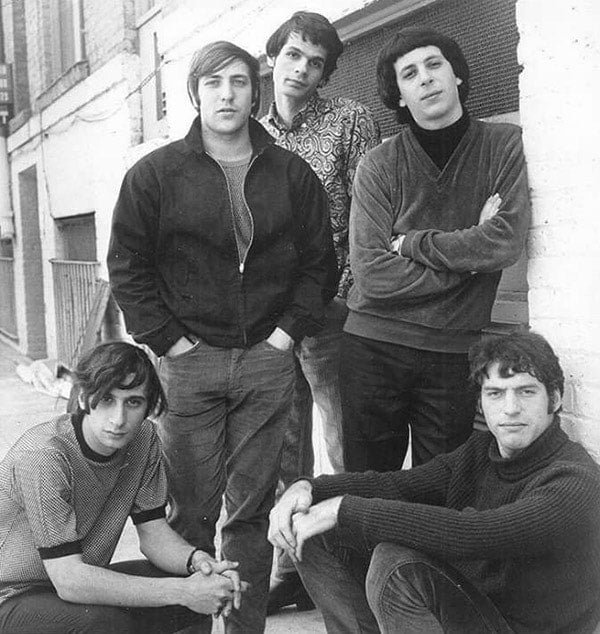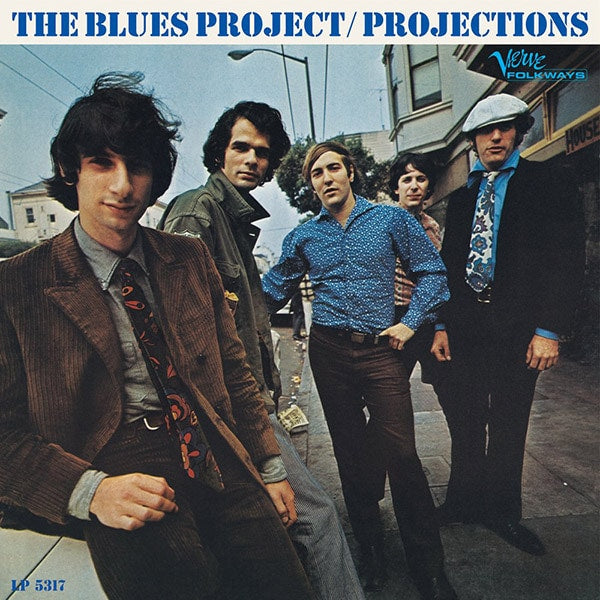It was my 13th birthday when my mother inquired if I had a preference for a birthday gift. I graciously asked for an album or two, as I was in the early throes of a lifelong addiction to music. I figured the Beatles and Stones would be in the mix, as both were charting regularly in the mid-1960s. My mother said she’d inquire at the local record shop for suggestions. It sounded like a good plan.
When she returned home with The Blues Project’s second album, Projections (1966), I was a bit miffed by her purchase. “I don’t know these guys,” I said, slightly hiding my disappointment. “The guy at Record World just raved about them,” mother replied.
It was an early life moment where, upon reflection, mom’s cool quotient was off the charts, and I was totally clueless. Nobody in my inner circle knew of the Blues Project, and I can honestly say I didn’t particularly care for their sound when the needle dropped on the LP. My adolescent and unsophisticated musical taste had a pop orientation, rather than the eclectic range of blues, rock, folk, R&B and jazz so well represented in the Projections LP. However, in the intervening years, with the benefit of age and wisdom, my appreciation for this album and this band has grown considerably.
So, who are The Blues Project? The lineup on Projections consisted of Danny Kalb (guitar, vocals), Steve Katz (guitar, vocals), Roy Blumenfeld (drums), Andy Kulberg (bass, flute) and Al Kooper (keyboards, vocals). A few of those guys may need an introduction, but certainly not Al Kooper, arguably the most underrated singer, songwriter, producer in modern-music history…and that’s no hyperbole!
The Blues Project were signed in 1965 to the Verve Folkways label, a subsidiary of MGM Records. Early artists signed to the label included such folk luminaries as Richie Havens, Janis Ian, Tim Hardin, Laura Nyro and Dave Van Ronk.
 The Blues Project.
The Blues Project.
The group were fixtures in the Greenwich Village music scene, and they had a particularly strong following on college campuses. Known for their live performances, the band’s first album release was a live recording captured at the famed New York City club Cafe Au Go Go, a venue the band played quite frequently.
A founding member and leading force of the band was Danny Kalb, a well-known session guitarist and protégé of Dave Van Ronk. Kalb had recorded with the likes of Pete Seeger, Judy Collins, Phil Ochs and Bob Dylan. In 1961 Kalb and Dylan performed a live concert broadcast on WBAI-FM, an NYC radio station that played a prominent role in the era’s counterculture movement.
Projections features a roughly 11-minute Kalb arrangement of Muddy Waters’ “Two Trains Running.” Kalb positively revered Waters, and the song was a staple of the band’s live performances. In 1965, Waters appeared on the same bill as The Blues Project at the Cafe Au Go Go. Kalb nervously asked Waters what he thought of their cover. Waters replied, “You really got to me.” Reflecting on that brief encounter, Kalb has said, somewhat in jest, “If I had dropped dead at that moment, my life would have been well spent.”
Projections also features the Chuck Berry track “You Can’t Catch Me.” Berry also had a big influence on Kalb and Kooper, as he did with so many artists of that era. The Blues Project once again had the good fortune of performing live with one its heroes at NYC’s Town Hall. Chuck Berry rarely traveled with his own band, so it often fell to a local promoter to assemble musicians to back up his set. For the Town Hall concert, that honor fell to The Blues Project. Said Kooper, “It was one of our first big gigs. We opened for him (Berry) and then we backed him. It was nerve-wracking because he was very difficult to work with. Fortunately I knew all of his songs so he didn’t give me any sh*t. He was very, very tough, the rehearsal was pretty scary.”
“Wake Me Shake Me “ is a gospel song originally recorded by The Golden Chords. Kooper, an admirer of gospel music, had heard the group perform the song live and loved it, but realized a Blues Project rendition would require a significantly different arrangement. “The song worked out very well because the band really got into it,” said Kooper. “It gave us a lot of room to improvise live. So it became our closer.”
“I Can’t Keep From Crying” is another gospel track originally recorded by Blind Willie Johnson in 1928. The song is perhaps best known by both the live and studio versions recorded by Alvin Lee and Ten Years After.
“Flute Thing” is a jazz-influenced instrumental featuring flautist Andy Kulberg, while “Steve’s Song” has folk roots and features Steve Katz on vocals. The song was intended to be called “September Fifth,” but for a bit of miscommunication between the band’s record label and management. “We were on the road a lot,” reminisced Katz, “and there were no cell phones in those days. Our record label (Verve Folkways) called our manager, who is like a total idiot, and said, ‘we have the artwork and the master tapes, but we’re missing the name of the second song on the first side.’ So our manager says, ‘Second song, first side? Second song, first side? Oh, that’s Steve’s song.’ We get off the road a week later and I’m reviewing (album cover) proofs and I cry out, what the hell is ‘Steve’s Song”?
Reflecting further on the song’s recording, Katz added, “I tried to do my vocal over again, and producer Tom Wilson said there wasn’t enough time because Eric Burdon (the Animals) was coming in. We were restricted by three-hour sessions, and that was pretty much it.” As a new and relatively unproven artist, the band wasn’t afforded a lot of leeway or consideration in production.
The liner notes to Projections were penned by the late promoter Sid Bernstein (the Beatles, the Rolling Stones, Herman’s Hermits). At the time, Bernstein had two artists under personal management contracts, The Young Rascals and The Blues Project. Under Bernstein’s tutelage, the band had hoped to achieve greater commercial success. In the Dec 17, 1966 issue of Billboard magazine, Bernstein outlined a development plan for The Blues Project that included “taking voice lessons to improve their technique – because 90 percent of their dates are college performances – and their staging.”
A prerequisite for a band’s success in the 1960s was a hit single (or 45), and the Projections LP sorely lacked one. The label released “I Can’t Keep From Crying” as a 45 but it didn’t receive very much airplay. The band’s only charting single was a trippy, psychedelic track called “No Time Like The Right Time” released in 1967. The song, written by Kooper, entered the Billboard Hot 100 chart and quickly petered out at 96. A few other Blues Project single releases also performed poorly. They just weren’t a singles band. Their style of music was better suited to live performance and AOR (album oriented rock) radio, which was just gaining traction as a radio format.
The band’s relationship with their record label (Verve Folkways) was never particularly healthy, nor did the label seemingly know how to market or promote the band. How bad was it? Well, the group didn’t hear the final mix or see the final cover art on Projections until the album was literally in the stores.
Their record label also excluded the names of individual band members from the album jacket, while album producer Tom Wilson’s credit is prominently displayed in exceedingly large type. The late Wilson was a highly accomplished producer (Bob Dylan, the Velvet Underground, Simon and Garfunkel), but hardly a household name with the listening public. The rather over the top liner credit was likely to assuage Wilson, an important producer for the Verve Folkways label.
The Band’s third album, The Blues Project Live At Town Hall (1967) inexplicably included only one song recorded live at Town Hall. Most of the songs were live recordings from other venues, or studio outtakes with overdubbed applause to give the appearance of a live recording. It’s not exactly in the Milli Vanilli scandal zone, but a head-scratcher nonetheless.
Al Kooper and Steve Katz went on to form Blood, Sweat & Tears. Kooper left BS&T after six months, but not before leaving a large imprint with the band’s debut LP, Child Is A Father To The Man (1968). Two Kooper-penned tracks from the album are the classics: “I Love You More Than You’ll Ever Know” and “I Can’t Quit Her.”
Over an astoundingly rich career, Kooper has recorded with Jimi Hendrix, B.B. King, The Who, Cream, Alice Cooper, George Harrison, and the Rolling Stones. Most ardent music fans are aware that Kooper serendipitously created one of the most memorable organ riffs ever heard on a Hammond B3 on Dylan’s “Like A Rolling Stone.” Many fans, however, are likely unaware that the French horn intro to the Stones’ “You Can’t Always Get What You Want” is also Kooper. Mick and Keith had invited Kooper to London to play on the Let It Bleed sessions.
While in London, Kooper suggested the Stones add a French horn intro to the song. Mick and Keith said they’d think about it. It didn’t take very long for the boys to relent, and Kooper subsequently recorded the French horn intro in a New York City studio.
Other highly regarded Kooper projects include the classic Al Kooper, Mike Bloomfield, Stephen Stills Super Session LP (1968), and his first solo album, I Stand Alone (1969). Kooper is also credited with discovering Lynyrd Skynyrd and producing the band’s first three albums, including the hit songs “Sweet Home Alabama,” “Saturday Night Special” and “Free Bird.” For a truly great read with fabulous stories, check out Kooper’s arguably best-ever-titled memoir, Backstage Passes & Backstabbing Bastards: Memoirs of a Rock ‘n’ Roll Survivor.”
Guitarist Steve Katz remained with BS&T’s for five years, including during the band’s heyday with lead vocalist David Clayton-Thomas. Katz went on to produce two Lou Reed albums, Sally Can’t Dance (1974) and Rock ‘n’ Roll Animal (1974). He later would form the band American Flyer, and then subsequently became an executive with Mercury Records.
The Blues Project’s Andy Kulberg and Roy Blumenfeld went on to form Seatrain, another great band, perhaps best known for their George Martin-produced LP The Marblehead Messenger (1971).
One of The Blues Project’s last performances in the 1960s was at the legendary Monterey International Pop Festival, which featured Otis Redding, Jimi Hendrix and The Byrds, among others. In 1973, The Blues Project briefly reunited and performed at the Schaefer Music Festival in NYC’s Central Park. That performance culminated with a live double album release, The Original Blues Project, Reunion In Central Park (1973). The band sporadically performed in the 1980s and 1990s with various members, and as recently as 2021 original members Katz and Blumenfeld did a few club dates.
The Blues Project never received the acclaim some members believe they deserved. Reflecting on the band’s legacy, Danny Kalb has said, “I think that the way the band has been either forgotten or dissed is disgraceful. We were one of the most exciting bands in the period. We really took big chances, both spiritually and musically.”
The Blues Project were like a fine wine uncorked without proper aging. The band’s live performances were so highly regarded – with almost cult-like appeal for many – perhaps with time and better management the band could have become a notable jam band, in the spirit of the Grateful Dead, the Allman Brothers, or Phish.
Yep, successful musical outcomes are often the result of bands having strong skills, good timing, and a heck of a lot of luck.


